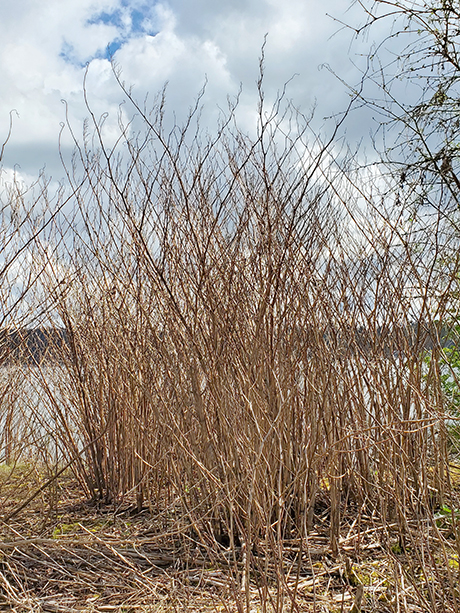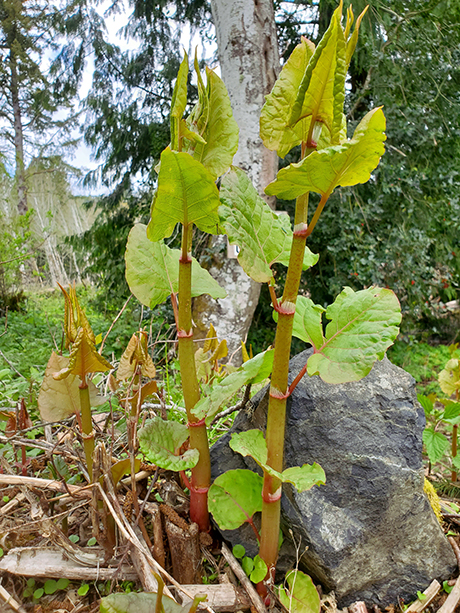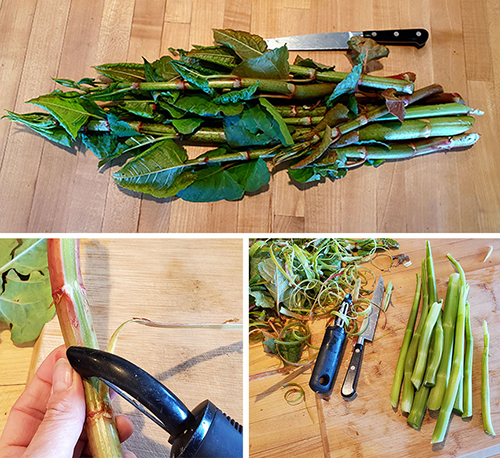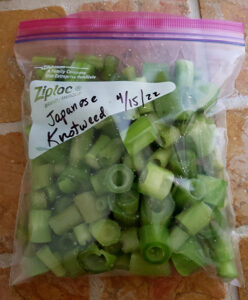20 Apr Japanese Knotweed
Posted at 15:07h
in Field Notes
 Japanese Knotweed
Japanese Knotweed
aka Polygonym cuspidatum
Reynoutria japonica
aka Fallopia japonica
If you’ve ever tangled with Knotweed, you’ll know it can be a formidable yard and garden foe. North American and European weed scientists are probably more terrified of this plant than any other in the Northern Hemisphere. And it’s now making its way around the Southern Hemisphere as well.
For now, let’s focus on four species of introduced Knotweeds: Japanese, Bohemian, Giant and Himalayan. They are all tall, robust perennials that spread by creeping rhizomes. These bamboo-like plants were introduced from Asia as garden ornamentals in the 1890s. They’ve become widely established throughout North America because they lack natural predators and are able to spread by root and stem fragments.
Since at least the 1990s, biologists have voiced growing concern about Knotweed because they can rapidly inhabit large open spaces appearing to, at least in the short term, crowd out native species and alter native habitats. Unfortunately, today most attempts at keeping knotweed in check involve applying broad spectrum herbicides like glyphosate, the active ingredient in Roundup. (Broad spectrum herbicides are non-selective in what they eradicate, so they also tend to take out the natives, as well as soil microbes, mosses, fungi and lichen.)

Knotweed shoots just right for harvesting.
What does it look like? Japanese Knotweed has hollow stems with distinct nodes that give it the appearance of bamboo. Stems can reach 10-13 feet high in a single growing season. The large alternating leaves are hairless, broad and oval with a smooth edge. Leaves are 2 to 4.5 inches wide. Small flowers are born on 2-6 inch spike-like clusters in late summer and early autumn. The young shoots are red. This abbreviated description fits each of the species mentioned above.
What parts can I eat? The young shoots are edible and nutritious. Once stems become woody, they are no longer palatable. Though I haven’t tried it myself, there are also a few accounts of people eating the cooked young leaves.
Are there any poisonous look-alikes? Pokeweed is often listed as a poisonous look-alike. However, pokeweed is consumed by many who are educated on which parts to harvest and how to prepare it. Also, pokeweed is not native to the Pacific Northwest, so you’re not likely to encounter it.
 Where can I find it? These Knotweeds occur in a wide variety of habitats, in many soil types and a range of moisture conditions. They are usually found in disturbed, open, sunny areas. They are commonly found on edges of roadways and streambanks. With a knife or snips, only harvest the young shoots and uppermost 10 inches of new growth. To peel knotweed, strip the leaves and use a vegetable peeler.
Where can I find it? These Knotweeds occur in a wide variety of habitats, in many soil types and a range of moisture conditions. They are usually found in disturbed, open, sunny areas. They are commonly found on edges of roadways and streambanks. With a knife or snips, only harvest the young shoots and uppermost 10 inches of new growth. To peel knotweed, strip the leaves and use a vegetable peeler.
Can I eat it? Definitely. The flavor is often described as an “earthy rhubarb” in flavor, and it’s become a popular foraged ingredient in some high end restaurants. Described as tart, sweet and crunchy, it can be eaten raw or cooked, and it can be incorporated in both sweet and savory dishes.
Young shoots, tender tips, and young leaves can be boiled, steamed or sauteed, and are used in pies, crisps, soups, sauces and chutneys.

Is it good for you? Japanese Knotweed is high in phenolic antioxidants and is a great source of vitamin A. It also contains plenty of vitamin C, phosphorus, zinc, potassium and manganese. It is rich in resveratrol, which is the same substance in red wine that is said to lower cholesterol and reduce the risk of heart attack. Resveratrol is also being studied for possible antiviral, anti-inflammatory and anticancer effects. Most resveratrol supplements sold in the US are sourced from Japanese knotweed.
Not ready to make your dish? Simply chop in 1” pieces and store in the freezer.
Knotweed Strawberry Crisp
You will notice that it doesn’t taste exactly like rhubarb. It should be appreciated for it’s own unique, earthy flavor.

Ingredients:
¾ c sugar
3 Tbs cornstarch
3 c sliced fresh knotweed
2 c sliced strawberries
1 c quick-cooking oats
½ c packed brown sugar
½ c butter, melted
1/3 c all-purpose flour
1 tsp ground cinnamon
Vanilla ice cream, optional
Method:
-
Preheat oven to 350F.
-
In a large bowl, combine sugar and cornstarch.
-
Add knotweed and strawberries; toss to coat.
-
Spoon into an 8-in. cast-iron skillet or other ovenproof skillet.
-
In a small bowl, combine the oats, brown sugar, butter, flour and cinnamon until the mixture resembles coarse crumbs.
-
Sprinkle over fruit. Bake at 350° until crisp is bubbly and fruit is tender, about 45 minutes. If desired, serve warm with ice cream.

